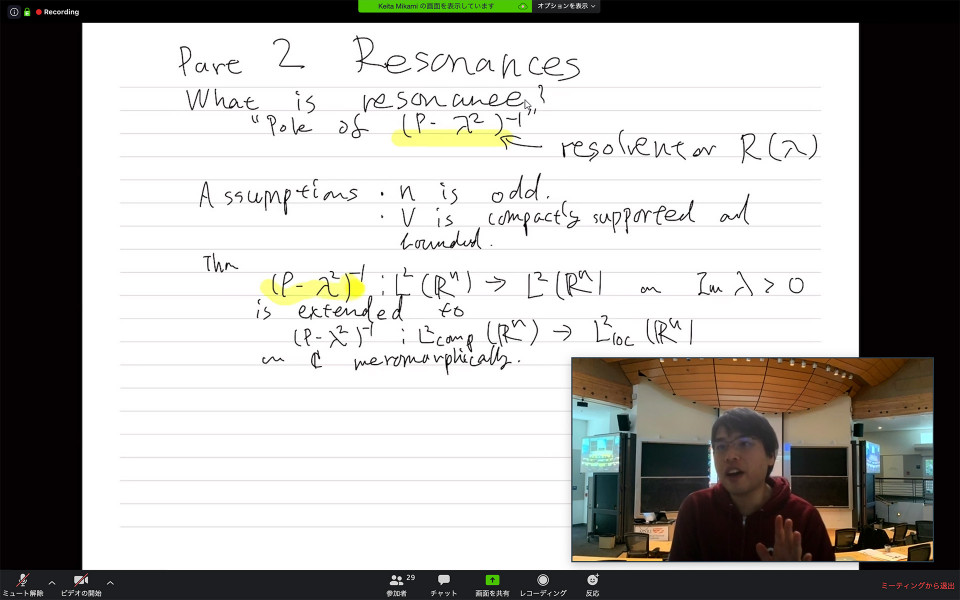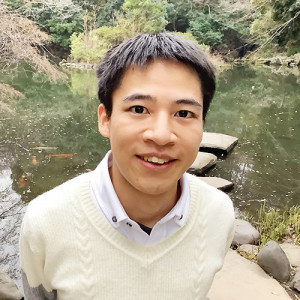Volume 104
Back to Newsletter List
Research News
Mesoscopic spin transport between strongly interacting Fermi gases
2020-05-18
Understanding of physical properties for quantum many-body systems with strong interparticle interactions is one of key issues common to various subfields of physics. Such systems range from high-Tc superconductors in solid-state physics to neutron star interiors in nuclear physics. Among these systems, ultracold atoms are very pure atomic gases whose interactions can be tuned by optical and/or magnetic fields. The ultracold atoms thus provide an ideal platform to simulate the strongly interacting systems.
Recently, quantum transport of ultracold atoms have been actively investigated in order to clarify how strong interactions affect their nonequilibrium properties. Motivated by this experimental situation, we theoretically study spin transport for strongly interacting Fermi gases in two-terminal setup where the gases in left and right reservoirs are connected via a narrow construction (see Figure). In particular, the spin current for normal Fermi gases in two situations are focused on. The first situation is the pseudogap region, where both gases have small spin polarizations and are above the superfluid transition temperature. In this case, spin-up and spin-down fermions in each reservoir prefer to form pairs (so-called preformed Cooper pairs) due to the strong attractive interaction. Because of this pairing effect, the spin degrees of freedom tend to be frozen and thus the spin current is largely suppressed. The other situation is a region where the gases in the left and right reservoirs have large spin polarizations with opposite sign. In this case, minority-spin particles behave as the “Fermi polarons,” which are quasiparticles consisting of minority-spin particles dressed by majority-spin ones. The appearance of the Fermi polarons results in the increase of the minority densities of states, leading to the enhancement of the spin current. Our results suggest that the spin transport measurement becomes a sensitive probe to experimentally examine pseudogap and polaron phenomena, which have attracted much attention not only in atomic physics but also in solid-state physics.
Seminar Report
First virtual Math Seminar on May 1, 2020
2020-05-20
The first iTHEMS Math seminar of this academic year was held on May 1st on Zoom, inviting our colleague Keita Mikami. The title of the talk was “From Eigenvalues to Resonances”. The main topic was Resonance, which is one of the most studied objects in mathematical study of Schrödinger operators.
In the first part, the speaker briefly reviewed spectral theory and how we use it in the study of Schrödinger operators, introducing some basic notions used in the study of Schrödinger operators. Especially, he explained that spectra can be classified into eigenvalues and continuous spectra. Then he introduced scattering theory, which can be used to analyze absolutely continuous spectra. One novelty is that generalized eigenfunction has a representation formula in terms of scattering matrices.
In the second part, the speaker gave a brief introduction of resonances and its application to both mathematicians and researchers in other fields. After introducing mathematical definition of resonances, he explained its applications in the other fields. One example was the following experimental result; when one makes a wave with certain frequency in aquarium, there appears special pattern in the distribution of speed. This phenomena can be explained mathematically by considering resonance of pseudodifferential operator on torus.
From Eigenvalues to Resonances
May 1 (Fri) 16:00 - 18:10, 2020
Upcoming Events
Seminar
iTHEMS Biology Seminar
Forgetting in Reinforcement Learning Links Sustained Dopamine Signals to Motivation
May 27 (Wed) 10:00 - 10:45, 2020
Ayaka Kato (RIKEN Center for Brain Science (CBS) / Ph.D. Student, The University of Tokyo)
Dopamine (DA) has been suggested to have two reward-related roles: (1) representing reward-prediction-error (RPE), and (2) providing motivational drive. Role(1) is based on the physiological results that DA responds to unpredicted but not predicted reward, whereas role(2) is supported by the pharmacological results that blockade of DA signaling causes motivational impairments such as slowdown of self-paced behavior. Whereas synaptic/circuit mechanisms for role(1), i.e., how RPE is calculated in the upstream of DA neurons and how RPE-dependent update of learned-values occurs through DA-dependent synaptic plasticity, have now become clarified, mechanisms for role(2) remain unclear. We modeled self-paced behavior by a series of ‘Go’ or ‘No-Go’ selections in the framework of reinforcement-learning assuming DA's role(1), and demonstrated that incorporation of decay/forgetting of learned-values, which is presumably implemented as decay of synaptic strengths storing learned-values, provides a potential unified mechanistic account for the DA's two roles, together with its various temporal patterns.
Venue: via Zoom
Event Official Language: English
Seminar
iTHEMS Math Seminar
Knotted 2-spheres in the 4-space and Yang-Mills gauge theory
May 27 (Wed) 16:00 - 18:10, 2020
Masaki Taniguchi (Special Postdoctoral Researcher, RIKEN Interdisciplinary Theoretical and Mathematical Sciences Program (iTHEMS))
The classification problem of knots is one of the central topics in a study of topology. In the first part, we review classical knot theory and theory of 2-dimensional knots in the 4-dimensional space. In the second part, we focus on a problem considered in differential topology. In the studies of differential topology, people are interested in the difference between continuous and smooth. As the main result of this talk, we introduce a theorem that tells us the difference between continuous and smooth 2-dimensional knots. The proof uses Yang-Mills gauge theory for 4-manifolds obtained by the surgery of 2-knots.
Venue: via Zoom
Event Official Language: English
Seminar
QFT-core Seminar
Localization and universality in non-Hermitian many-body systems
May 29 (Fri) 15:00 - 16:30, 2020
Ryusuke Hamazaki (Senior Research Scientist, RIKEN Interdisciplinary Theoretical and Mathematical Sciences Program (iTHEMS) / RIKEN Hakubi Team Leader, Nonequilibrium Quantum Statistical Mechanics RIKEN Hakubi Research Team, RIKEN Cluster for Pioneering Research (CPR))
Recent study on isolated quantum many-body systems have revealed two different phases distinguished by their dynamics and spectral statistics. One is an ergodic phase whose spectral statistics exhibit universality of random matrices, and the other is a many-body localized phase where dynamics is constrained due to strong disorder. In this talk, we show that novel and rich physics concerning such localization and universality appears in non-Hermitian many-body systems, which have been utilized in diverse scientific disciplines from open quantum systems to biology.
As a first topic, we analyze non-Hermitian quantum many-body systems in the presence of interaction and disorder [1]. We demonstrate that a novel real-complex transition occurs upon many-body localization of non-Hermitian interacting systems with asymmetric hopping that respect time-reversal symmetry. As a second topic, we show that “Dyson’s threefold way,” a threefold symmetry classification of universal spectral statistics of random matrices, is nontrivially extended to non-Hermitian random matrices [2]. We report our discovery of two distinct universality classes characterized by transposition symmetry, which is distinct from time-reversal symmetry due to non-Hermiticity. We show that the newly found universality classes indeed manifest themselves in dissipative quantum many-body ergodic systems described by Lindblad equations.
References
- RH, K. Kawabata, and M. Ueda, Phys. Rev. Lett. 123, 090603 (2019)
- RH, K. Kawabata, N. Kura and M. Ueda, Phys. Rev. Research, to appear (2020)
Venue: via Zoom
Event Official Language: English
Paper of the Week
Week 4 of May
2020-05-21
Title: Test of Eigenstate Thermalization Hypothesis Based on Local Random Matrix Theory
Author: Shoki Sugimoto, Ryusuke Hamazaki, Masahito Ueda
arXiv: http://arxiv.org/abs/2005.06379v1
Title: Black Hole as a Quantum Field Configuration
Author: Hikaru Kawai, Yuki Yokokura
arXiv: http://arxiv.org/abs/2002.10331v3
Title: F_K / F_π from Möbius Domain-Wall fermions solved on gradient-flowed HISQ ensembles
Author: Nolan Miller, Henry Monge-Camacho, Chia Cheng Chang, Ben Hörz, Enrico Rinaldi, Dean Howarth, Evan Berkowitz, David A. Brantley, Arjun Singh Gambhir, Christopher Körber, Christopher J. Monahan, M. A. Clark, Bálint Joó, Thorsten Kurth, Amy Nicholson, Kostas Orginos, Pavlos Vranas, André Walker-Loud
arXiv: http://arxiv.org/abs/2005.04795v2
If you would like to cancel your subscription or change your email address,
please let us know via our contact form.
Copyright © iTHEMS, RIKEN. All rights reserved.







